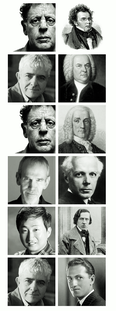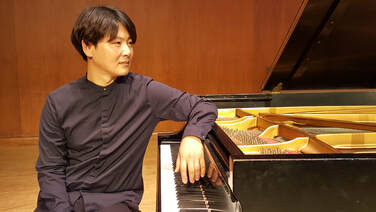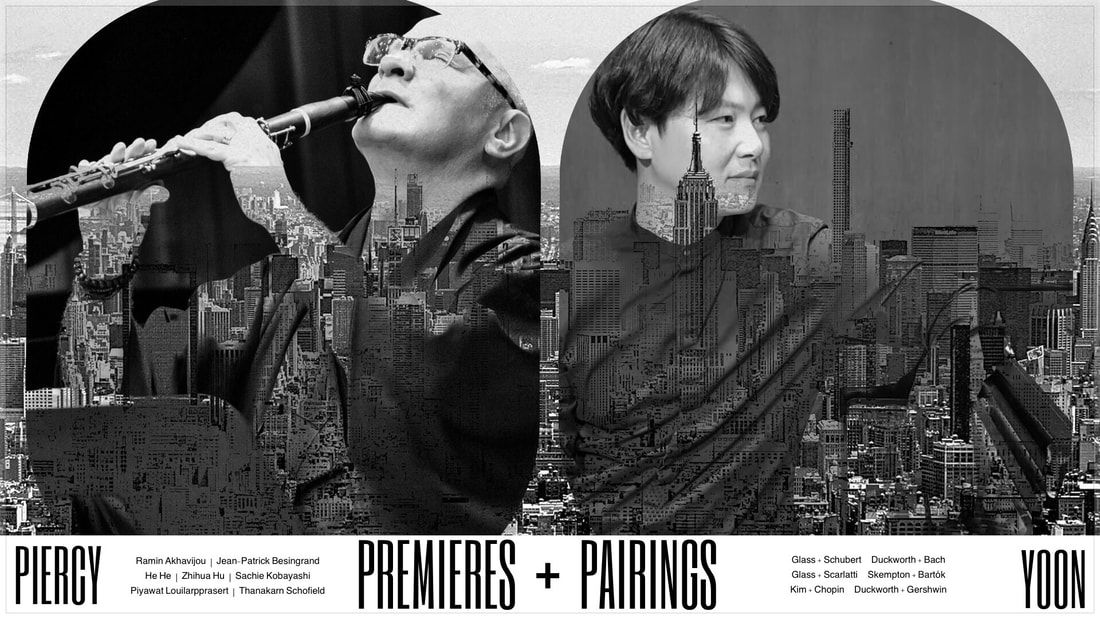PREMIERES + PAIRINGS
THOMAS PIERCY, Clarinet/Bass Clarinet & Hichiriki
JIUNG YOON, Piano
A concert of premieres and pairings.
Premieres: Solo and duo works for clarinet/bass clarinet, hichiriki and piano by composers from around the world.
Pairings: "...but I repeat myself..." a program of minimalist/repetivist piano music pairings.
THOMAS PIERCY, Clarinet/Bass Clarinet & Hichiriki
JIUNG YOON, Piano
A concert of premieres and pairings.
Premieres: Solo and duo works for clarinet/bass clarinet, hichiriki and piano by composers from around the world.
Pairings: "...but I repeat myself..." a program of minimalist/repetivist piano music pairings.
PREMIERES

Ramin Akhavijou (Iran) "1X - One to the Power of X" for solo clarinet *
Jean-Patrick Besingrand (France) “Izanagi” for solo bass clarinet *
Zhihua Hu (China) “Nine Tone Trio for Two” for clarinet/hichiriki and piano *
Sachie Kobayashi (Japan) “Miniature” for clarinet and piano *
Piyawat Louilarpprasert (Thailand) “3 Tones” for clarinet and tape *
Thanakarn Schofield (Thailand) “Petunia Dance” for clarinet and piano *
* World Premiere | Composed for Thomas Piercy
PAIRINGS

Opening, Philip Glass + Ständchen, Franz Schubert, arr. Liszt
Time Curve Preludes: No.14, William Duckworth + Prelude No.6 in D Minor, J.S. Bach
Etude No.6, Philip Glass + Sonata in D Minor, K.141, Domenico Scarlatti
Prelude No.7, from Images, Howard Skempton + Hungarian Peasant Songs, Béla Bartók
Sense Datum, Joungmin Lee + Nocturne No.19 in E minor, Op.72, No.1, Fréderic Chopin
Time Curve Preludes: No.22, William Duckworth + Jazzbo Brown Blues, George Gershwin
Opening, Philip Glass + Ständchen, Franz Schubert, arr. Liszt
Time Curve Preludes: No.14, William Duckworth + Prelude No.6 in D Minor, J.S. Bach
Etude No.6, Philip Glass + Sonata in D Minor, K.141, Domenico Scarlatti
Prelude No.7, from Images, Howard Skempton + Hungarian Peasant Songs, Béla Bartók
Sense Datum, Joungmin Lee + Nocturne No.19 in E minor, Op.72, No.1, Fréderic Chopin
Time Curve Preludes: No.22, William Duckworth + Jazzbo Brown Blues, George Gershwin

TENRI
43 W 13th St. NY, NY 10011 Friday at 7pm May 17, 2019 |
Tickets available at the door or the Brown Paper Tickets button above.
For Reservations or more information: tonadaproductions@gmail.com www.tonadaproductions.com/premieres--pairings-piercy--joon www.tenri.org |

Thomas Piercy is a critically acclaimed musician with orchestral, concerto, recital and chamber music appearances throughout the Americas, Europe and Asia. He has been described by The New York Times as “Brilliant...playing with refinement and flair…evoking a panache in the contemporary works.” A versatile artist defying categorization – performing on the Emmy Award-winning Juno Baby CDs and DVDs; performing with pianist Earl Wild and Frederica von Stade; working with Leonard Bernstein; appearing in a KRS-ONE music video; playing hichiriki in Japan; recording with members of Maroon 5; premiering over 200 works composed for him; performing on Broadway and Off-Broadway, television, radio, and commercial recordings. Studied at the Juilliard School and Mannes School of Music. Clarinet studies with Gervase De Peyer, Dr. Stephen Johnston, Leon Russianoff, and Kalmen Opperman; hichiriki studies with Hitomi Nakamura. Recordings for Albany, Capstone, DGI, Changing Tones, NJST, Tonada Records and more. More information: www.thomaspiercy.com

Jiung Yoon initially studied piano in South Korea, where he won the IBACH Music Competition and the National Music Concours Scholarship. He was awarded a scholarship to Bowling Green State University in Ohio, where he studied with Laura Melton. He then went on to complete his doctorate in piano performance at Ohio State University in Columbus, where he studied with Steven Glaser. Jiung Yoon is now in high demand in central Ohio as a soloist, collaborative pianist, coach, and teacher. While maintaining a large private studio of students, he has worked as a professional accompanist for hundreds of instrumental and vocal concerts and international music festivals and competitions in Korea, the United States and Europe. He has been the official collaborator at national and international events sponsored by the International Clarinet Association, the Central Ohio Flute Association, and the National Conference of the Society of Composers, Inc. He has also worked with high-profile guest artists in master classes and recitals -- among them Richard Stoltzman, Stephen Hough, Gilbert Kalish, Carol Wincenc, Margo Garrett and Timothy Myers.
Pairings: "...but I repeat myself..." a program of minimalist/repetivist piano music pairings.
Minimalist techniques and repetitiveness -- once considered a musical anti-language, and a provocational tool of anti-modernists -- have become perfectly mainstream. Twentieth-century European modernists aimed for an ideal of constant variation and continual harmonic change. (Arnold Schoenberg, creator of twelve-tone music, worked from the basic creed that "unvaried repetition is cheap.") 1960s minimalist composers like Terry Riley, Philip Glass, Steve Reich, and Howard Skempton strongly rejected that variation-ideal, instead embracing simplicity, audibility, intelligibility, informality. Now, in the early twenty-first century, repetition has become the lingua franca -- to be heard in movie scores, commercials, and the latest pop music. It shows a new relationship with time; it affirms tonality as a basic ethical principle; it tells us commodities aren't bad things. But repetition had always been an option before modernism arrived, and was in fact something of real expressive power. Today's piano music pairs minimalist/repetitivist pieces with earlier music, showing an old/new commonality and revealing the abnormality of modernism. We hope our sequence of pieces will have the effect of collapsing history, leaving you unable to tell the old from the new.
Pairings: "...but I repeat myself..." a program of minimalist/repetivist piano music pairings.
Minimalist techniques and repetitiveness -- once considered a musical anti-language, and a provocational tool of anti-modernists -- have become perfectly mainstream. Twentieth-century European modernists aimed for an ideal of constant variation and continual harmonic change. (Arnold Schoenberg, creator of twelve-tone music, worked from the basic creed that "unvaried repetition is cheap.") 1960s minimalist composers like Terry Riley, Philip Glass, Steve Reich, and Howard Skempton strongly rejected that variation-ideal, instead embracing simplicity, audibility, intelligibility, informality. Now, in the early twenty-first century, repetition has become the lingua franca -- to be heard in movie scores, commercials, and the latest pop music. It shows a new relationship with time; it affirms tonality as a basic ethical principle; it tells us commodities aren't bad things. But repetition had always been an option before modernism arrived, and was in fact something of real expressive power. Today's piano music pairs minimalist/repetitivist pieces with earlier music, showing an old/new commonality and revealing the abnormality of modernism. We hope our sequence of pieces will have the effect of collapsing history, leaving you unable to tell the old from the new.


